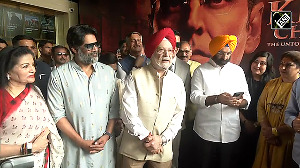The Reserve Bank of India (RBI) is expected to cut interest rates for the first time in nearly five years in Governor Sanjay Malhotra’s first monetary policy committee (MPC) meeting on Wednesday.

The meeting of the six-member MPC, which will culminate on Friday, aims to boost sluggish economic growth, which is seen falling to a four-year low.
Malhotra took charge as the 26th RBI governor in December last year.
The government is yet to announce an economist deputy governor in RBI after Michael Patra’s term ended in mid-January.
An economist deputy governor takes charge of the monetary policy department and hence a member of the monetary policy committee. Following Patra’s exit, the monetary policy department is now under M Rajeshwar Rao who looks after regulation, among others.
“Markets will be closely monitoring the statement of the newly appointed RBI governor, and we expect the policy statement to have a dovish undertone even while remaining cautious on the global front,” economists at CareEdge Ratings said.
They expect a rate cut of 25 basis points (bps), while retaining a neutral stance.
“We anticipate that the RBI could revise its growth projections of 6.6 per cent for FY25 marginally downwards to bring it in line with the First Advance Estimate (FAE).”
The FAE projects GDP growth to slow to 6.4 per cent in FY25 compared to 8.2 per cent growth in FY24.
The RBI emphasised on the need for headline inflation reaching the 4 per cent target for any rate action and highlighted the slow pace of the last mile disinflation.
It remains to be seen if the MPC now draws comfort from falling future trajectory on inflation rather than past prints.
Headline inflation sprinted above 5 per cent in the past four months, while core inflation was relatively stable.
The rate cut cycle could be shallow given the inflation concerns, particularly the sharp depreciation of the rupee in recent times.
“We are expecting a dovish tone, and a shallow rate cut cycle because we have to look in the context of how much the RBI has raised rates, it was 250 bps, so there is not much room to cut interest rate,” said Sakshi Gupta, principal economist at HDFC Bank.
“And they’ll have to remain cautious of inflation. A 50 basis points to 75 basis points rate cut should be able to achieve the neutral rate,” Gupta added.
The rupee has come under pressure in recent months, the first after the rate cut by the US Federal Reserve in September, and then the return of Donald Trump as the US president with the threat of imposing import tariffs.
On Sunday, Trump decided to impose a 25 per cent tariff on Canara and Mexico and 10 per cent additional levy on China.
Within 24 hours, he decided to hold on to the decision for 30 days for Canada and Mexico.
The Indian unit depreciated 1.31 per cent in December and 1.26 per cent in January. In February, it fell 0.53 per cent against the dollar.
"The rupee is under pressure, and with the ongoing strength of the dollar, further depreciation is likely.
"While a rate cut could weigh on the rupee, the broader weakness in emerging market currencies, driven by external factors like Trump's trade policies, is already impacting the rupee,” said the treasury head at a private bank.
“A rate cut should not be avoided solely due to currency concerns.
"I foresee the rupee reaching 87.50 soon, as it has already crossed 87.20.
"The MPC will likely focus more on the inflation-growth dynamics rather than currency factors, with currency weakness being influenced more by global trade tensions,” the treasury head added.
RBI’s intervention in the foreign exchange market to curb also made the liquidity situation tight prompting the central bank to announce measures like open market operation to purchase bonds to ease the situation.
A section of market participants expects clarity on the liquidity issue since the system is still in deficit.
"I expect a rate cut along with some clarity on the proposed liquidity guidelines.
"While a rate cut could impact the rupee, external factors are already influencing its movement, and growth remains a key concern," said Anshul Chandak, head of treasury at RBL Bank.
RBI had reduced banks’ cash reserve ratio requirement by 50 bps to 4 per cent in the December policy, which released Rs 1.16 trillion.
A further Cash Reserve Ratio (CRR) cut is not seen in the February policy.
"We expect the central bank to prioritise durable liquidity infusion, primarily through OMO and bond buy-sell mechanisms, rather than a CRR cut—at least not in February,” said Gaura Sen Gupta, chief economist at IDFC FIRST Bank.
“However, a CRR cut later in the year cannot be ruled out if additional liquidity is needed,” she said.
The latest data shows the liquidity deficit fell to Rs 1.08 trillion on Monday, from over Rs 3 trillion before the RBI announced measures like open market operation.












 © 2025
© 2025